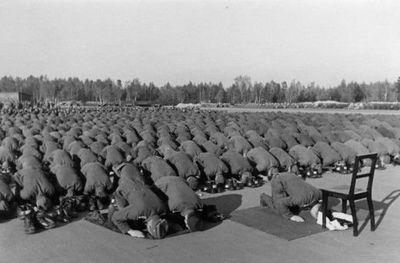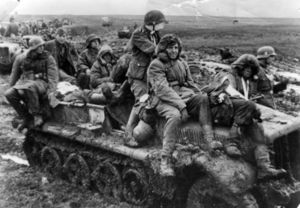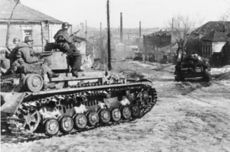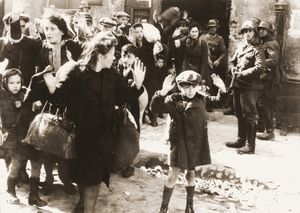ڤافن-إسإس
| Waffen-SS | |
|---|---|
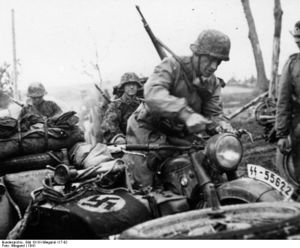 Waffen-SS in the Baltic states | |
| نشطة | 1933–45 |
| البلد | |
| الولاء | |
| الفرع | |
| النوع | |
| الحجم | 900,000 including foreign volunteers and conscripts[1] List of Waffen SS units |
| جزء من | SS; under operational control of the OKW and Kommandostab Reichsführer-SS |
| مقر الحامية | SS Führungshauptamt, Berlin |
| الاشتباكات | World War II |
| القادة | |
| كبير التشريفات | Heinrich Himmler |
| أبرز القادة | |
The Waffen-SS (النطق الألماني: [ˈvafən.ɛs.ɛs], Armed SS) was the armed wing of the Nazi Party's SS organisation. Its formations included men from Nazi Germany, along with volunteers and conscripts from both occupied and un-occupied lands.[2]
The Waffen-SS grew from three regiments to over 38 divisions during World War II, and served alongside the Heer (regular army), Ordnungspolizei (uniformed police) and other security units. Originally, it was under the control of the SS Führungshauptamt (SS operational command office) beneath Reichsführer-SS Heinrich Himmler. With the start of World War II, tactical control was exercised by the High Command of the Armed Forces (OKW),[3] with some units being subordinated to Kommandostab Reichsführer-SS (Command Staff Reichsführer-SS) directly under Himmler's control.[4]
Initially, in keeping with the racial policy of Nazi Germany, membership was open only to people of Germanic origin (so-called Aryan ancestry).[5] The rules were partially relaxed in 1940,[6][7] and later the formation of units composed largely or solely of foreign volunteers and conscripts was authorised. These SS units were made up of men mainly from among the nationals of Nazi-occupied Europe. Despite relaxation of the rules, the Waffen-SS was still based on the racist ideology of Nazism, and ethnic Poles (who were viewed as subhumans) were barred specifically from the formations.[8][9][10]
Members of the Waffen-SS were involved in numerous atrocities.[11] At the post-war Nuremberg trials, the Waffen-SS was judged to be a criminal organisation due to its connection to the Nazi Party and direct involvement in numerous war crimes and crimes against humanity. Former Waffen-SS members were denied many of the rights afforded to the military veterans. An exception was made for Waffen-SS conscripts, who were exempted because they were not volunteers.[12][13] About a third of the total membership were conscripts.[14]
Origins (1929–39)

The origins of the Waffen-SS can be traced back to the selection of a group of 120 SS men on 17 March 1933 by Sepp Dietrich to form the Sonderkommando Berlin.[15] By November 1933 the formation had 800 men, and at a commemorative ceremony in Munich for the tenth anniversary of the failed Munich Putsch the regiment swore allegiance to Adolf Hitler. The oaths pledged were "Pledging loyalty to him alone" and "Obedience unto death".[15] The formation was given the title Leibstandarte (Bodyguard Regiment) Adolf Hitler (LAH).[16] On 13 April 1934, by order of Himmler, the regiment became known as the Leibstandarte SS Adolf Hitler (LSSAH).[16]
World War II
1939
Invasion of Poland
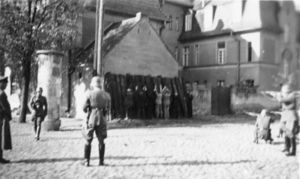
1940 expansion
Himmler gained approval for the Waffen-SS to form its own high command, the Kommandoamt der Waffen-SS within the SS-Führungshauptamt, which was created in August 1940.[17] It received command of the SS-VT (the Leibstandarte and the Verfügungs-Division, renamed Reich) and the armed SS-TV regiments (the Totenkopf-Division together with several independent Totenkopf-Standarten).[18]
1941
Balkans
Soviet Union
Operation Barbarossa, the German invasion of the Soviet Union, started on 22 June 1941, and all the Waffen-SS formations participated (including the SS Reich, which was formally renamed to SS Das Reich by the Fall of 1941).[19]
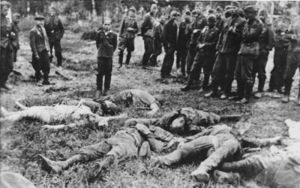
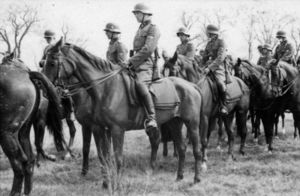
1942
1942 expansion
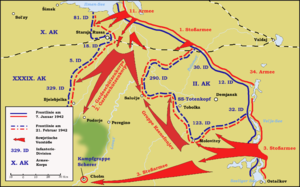
1943
1943 expansion
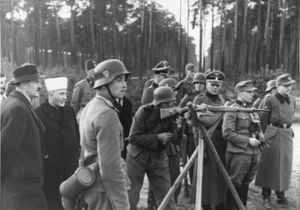
Kharkiv
1944
1944 expansion
Criminality
The Allgemeine SS was responsible for the administration of both the concentration and extermination camps. Many members of it and the SS-Totenkopfverbände subsequently became members of the Waffen-SS, forming the initial core of the 3rd SS Totenkopf Division.[21][22] A number of SS medical personnel who were members of the Waffen-SS were convicted of crimes during the "Doctors' trials" in Nuremberg, held between 1946 and 1947 for the Nazi human experimentation they performed at the camps.
See also
- German war crimes
- Glossary of Nazi Germany
- List of Knight's Cross recipients of the Waffen-SS
- List of SS personnel
- List of Waffen-SS units
- Signal Corps of the Wehrmacht and Waffen SS
- SS-Standarte Kurt Eggers
- SS and Police Leader
- Table of ranks and insignia of the Waffen-SS
- Uniforms and insignia of the Schutzstaffel
Explanatory notes
References
Citations
- ^ Neitzel & Welzer 2012, p. 290.
- ^ Stein 1984, pp. xxiv, xxv, 150, 153.
- ^ Stein 1984, p. 23.
- ^ The Nazi Holocaust. Part 3: The "Final Solution": The Implementation of Mass Murder. Volume 2, p. 459, De Gruyter, 1989
- ^ Stackelberg 2002, p. 116.
- ^ Langer & Rudowski 2008, p. 263.
- ^ Król 2006, pp. 452, 545.
- ^ W. Borodziej, Ruch oporu w Polsce w świetle tajnych akt niemieckich, Część IX, Kierunki 1985, nr 16.
- ^ Polska i Polacy w propagandzie narodowego socjalizmu w Niemczech 1919-1945 Eugeniusz Cezary Król Instytut Studiów Politycznych Polskiej Akademii Nauk, 2006, page 452
- ^ Terror i polityka: policja niemiecka a polski ruch oporu w GG 1939-1944 Włodzimierz Borodziej Instytut Wydawniczy Pax, 1985, p. 86.
- ^ "Waffen-SS: Mračne sile zločinačke politike - Vojnici nacionalsocijalizma 1933.-45." ("Waffen-SS: The Dark Forces Of Villain Politics - The Soldiers Of Nationalsocialism 1933-45"), p 9, Hrvoje Spajić, 2010.
- ^ {{{author}}}, Two Hundred And Seventeenth Day, [[{{{publisher}}}]], September 1946.
- ^ Laar, Mart (2005). "Battles in Estonia in 1944". Estonia in World War II. Tallinn: Grenamder. pp. 32–59.
- ^ McDonald, Gabrielle Kirk; Swaak-Goldman, Olivia (2000). Substantive and Procedural Aspects of International Criminal Law: The Experience of International and National Courts: Materials. BRILL. p. 695.
- ^ أ ب Flaherty 2004, p. 144.
- ^ أ ب Cook & Bender 1994, pp. 17, 19.
- ^ Stein 1984, p. 102.
- ^ Stein 1984, pp. 7, 103–106.
- ^ Stein 1984, p. 104.
- ^ Thomson 2004.
- ^ Flaherty 2004, p. 149.
- ^ Flaherty 2004, p. 150.
Bibliography
- Ailsby, Christopher (2004). Hitler's Renegades: Foreign Nationals in the Service of the Third Reich. Brasseys. ISBN 1-57488-838-2.
{{cite book}}: Invalid|ref=harv(help) - Bartrop, Paul R.; Jacobs, Leonard, eds. (2014). Modern Genocide: The Definitive Resource and Document Collection. Vol. 1. Santa Barbara, Calif.: ABC-CLIO. ISBN 978-1-61069-363-9 http://www.abc-clio.com/ABC-CLIOCorporate/product.aspx?pc=A4051C.
{{cite encyclopedia}}: Invalid|ref=harv(help); Missing or empty|title=(help) - "Battle of the Bulge". Retrieved 2 June 2013.
- Beevor, Antony (2002). Berlin: The Downfall 1945. Viking-Penguin Books. ISBN 978-0-670-03041-5.
{{cite book}}: Invalid|ref=harv(help) - Bell, Bowyer J (1966). Besieged: Seven Cities Under Siege. Chilton.
{{cite book}}: Invalid|ref=harv(help) - Bercuson, David (2004) [1996]. Maple Leaf Against the Axis. Red Deer Press. ISBN 0-88995-305-8.
{{cite book}}: Invalid|ref=harv(help) - Bergstrom, Christopher (2007). Kursk – The Air Battle: July 1943. Chervron/Ian Allen. ISBN 978-1-903223-88-8.
{{cite book}}: Invalid|ref=harv(help) - Bishop, Chris; Williams, Michael (2003). SS: Hell on the Western Front. St Paul, Minn: MBI Publishing. ISBN 978-0-7603-1402-9.
{{cite book}}: Invalid|ref=harv(help) - Browning, Christopher (2007). The Origins of the Final Solution: The Evolution of Nazi Jewish Policy, September 1939 – March 1942. University of Nebraska Press. ISBN 0-8032-5979-4.
{{cite book}}: Invalid|ref=harv(help) - Butler, Rupert (2001). SS-Leibstandarte: The History of the First SS Division, 1934–45. Spellmount.
{{cite book}}: Invalid|ref=harv(help) - Conot, Robert E. (1984). Justice at Nuremberg. Carrol & Graf.
{{cite book}}: Invalid|ref=harv(help) - Cook, Stan; Bender, Roger James (1994). Leibstandarte SS Adolf Hitler: Uniforms, Organization, & History. San Jose, CA: R. James Bender. ISBN 978-0-912138-55-8.
{{cite book}}: Invalid|ref=harv(help) - Cuppers, Martin (2006). Vorreiter der Shoah, Ein Vergleich der Einsätze der beiden SS-Kavallerieregimenter im August 1941 (in German). Meidenbauer Martin Verlag. ISBN 3-89975-080-2.
{{cite book}}: Invalid|ref=harv(help)CS1 maint: unrecognized language (link) - Diehl, James M. (1993). Thanks of the Fatherland: German Veterans After the Second World War. Chapel Hill: University of North Carolina Press. ISBN 978-0-8078-2077-3.
{{cite book}}: Invalid|ref=harv(help) - Dollinger, Hans (1967) [1965]. The Decline and Fall of Nazi Germany and Imperial Japan. New York: Bonanza. ISBN 978-0-517-01313-7.
{{cite book}}: Invalid|ref=harv(help) - Duffy, Christopher (2002). Red Storm on the Reich: The Soviet March on Germany, 1945. Edison, NJ: Castle Books. ISBN 0-7858-1624-0.
{{cite book}}: Invalid|ref=harv(help) - Ellis, L.F. (2004) [1968]. Butler, J. R. M. (ed.). Victory in the West, Volume II: The Defeat of Germany. History of the Second World War United Kingdom Military Series. Naval & Military Press. ISBN 1-84574-059-9.
{{cite book}}: Invalid|ref=harv(help) - Evans, Richard J. (2008). The Third Reich at War. New York: Penguin. ISBN 978-0-14-311671-4.
{{cite book}}: Invalid|ref=harv(help) - Eyre, Wayne (2006). "Operation RÖSSELSPRUNG and The Elimination of Tito, May 25, 1944: A Failure in Planning and Intelligence Support". Journal of Slavic Military Studies. Routledge, part of the Taylor & Francis Group. 19 (2): 343–376. doi:10.1080/13518040600697969.
{{cite journal}}: Invalid|ref=harv(help) - Fellgiebel, Walther-Peer (2000). Die Träger des Ritterkreuzes des Eisernen Kreuzes 1939–1945. Wölfersheim-Berstadt, Germany: Podzun-Pallas. ISBN 3-7909-0284-5.
{{cite book}}: Invalid|ref=harv(help) - Fey, William (2003). Armor Battles of the Waffen-SS. Stackpole. ISBN 978-0-8117-2905-5.
{{cite book}}: Invalid|ref=harv(help) - Fischer, Thomas (2008). Soldiers of the Leibstandarte. J.J. Fedorowicz Publishing. ISBN 978-0-921991-91-5.
{{cite book}}: Invalid|ref=harv(help) - Flaherty, T. H. (2004) [1988]. The Third Reich: The SS. Time-Life. ISBN 1-84447-073-3.
{{cite book}}: Invalid|ref=harv(help) - Forbes, Robert (2010) [2006]. For Europe: The French Volunteers of the Waffen-SS. Stackpole Books. ISBN 978-0-8117-3581-0.
{{cite book}}: Invalid|ref=harv(help) - Fritz, Stephen (2011). Ostkrieg: Hitler's War of Extermination in the East. Lexington: The University Press of Kentucky. ISBN 978-0-81313-416-1.
{{cite book}}: Invalid|ref=harv(help) - Gosztony, Peter (1978). Endkampf an der Donau 1944/45 (in German). Vienna: Molden Taschenbuch Verlag. ISBN 3-217-05126-2.
{{cite book}}: Invalid|ref=harv(help)CS1 maint: unrecognized language (link) - "Götz von Berlichingen Diary". Retrieved 24 May 2013.
- "Greeks lose Nazi massacre claim". BBC News. 26 June 2003. Retrieved 2 June 2013.
- Hannes, Heer; Naumann, Klaus (2000). War of Extermination: The German Military in World War II 1941–1944. Berghahn. ISBN 1-57181-232-6.
{{cite book}}: Invalid|ref=harv(help) - Harclerode, Peter (2005). Wings Of War – Airborne Warfare 1918–1945. Weidenfeld & Nicolson. ISBN 978-0-304-36730-6.
{{cite book}}: Invalid|ref=harv(help) - Harman, Nicholas (1980). Dunkirk: The Necessary Myth. Hodder and Stoughton. ISBN 0-340-24299-X.
{{cite book}}: Invalid|ref=harv(help) - Hastings, Max (2006) [1985]. Overlord: D-Day and the Battle for Normandy. Vintage. ISBN 0-307-27571-X.
{{cite book}}: Invalid|ref=harv(help) - Hastings, Max (2013). Das Reich: The March of the 2nd SS Panzer Division through France, June 1944. Minneapolis USA: Zenith Press. ISBN 978-0-7603-4491-0.
- "Italy convicts Nazis of massacre". BBC News. 13 January 2007. Retrieved 2 June 2013.
- Jackson, Julian (2001). The Fall of France: The Nazi Invasion of 1940. Oxford University Press. ISBN 0-19-280550-9.
{{cite book}}: Invalid|ref=harv(help) - Jarymowycz, Roman (2001). Tank Tactics: From Normandy to Lorraine. Lynne Rienner. ISBN 1-55587-950-0.
{{cite book}}: Invalid|ref=harv(help) - Kershaw, Ian (2008). Hitler: A Biography. New York: W. W. Norton & Company. ISBN 978-0-393-06757-6.
{{cite book}}: Invalid|ref=harv(help) - Kirchmayer, Jerzy (1978). Powstanie Warszawskie (in Polish). Książka i Wiedza. ISBN 83-05-11080-X.
{{cite book}}: Invalid|ref=harv(help)CS1 maint: unrecognized language (link) - Król, Eugeniusz C. (2006). Polska i Polacy w propagandzie narodowego socjalizmu w Niemczech 1919–1945 (in Polish). Warsaw: Instytut Studiów Politycznych Polskiej Akademii Nauk. ISBN 978-83-7399-019-7.
{{cite book}}: Invalid|ref=harv(help)CS1 maint: unrecognized language (link) - Langer, Howard J.; Rudowski, Marek (2008). Księga najważniejszych postaci II wojny światowej (in Polish). Warsaw: Bellona. ISBN 978-83-11-11111-0.
{{cite book}}: Invalid|ref=harv(help)CS1 maint: unrecognized language (link) - Large, David C. (1987). "Reckoning without the Past: The HIAG of the Waffen-SS and the Politics of Rehabilitation in the Bonn Republic, 1950–1961". The Journal of Modern History. University of Chicago Press. 59 (1): 79–113. doi:10.1086/243161. JSTOR 1880378.
{{cite journal}}: Invalid|ref=harv(help) - Latimer, Jon (2001). "World War II: 12th SS Hitlerjugend Panzer Division Fought in Normandy". World War II (July). Retrieved 16 February 2009.
{{cite journal}}: Invalid|ref=harv(help) - Levenda, Peter (2014). The Hitler Legacy: The Nazi Cult in Diaspora: How it was Organized, How it was Funded, and Why it Remains a Threat to Global Security in the Age of Terrorism. Lake Worth, Fla.: Ibis Press. ISBN 978-0-89254-210-9.
{{cite book}}: Invalid|ref=harv(help) - "Lawrenceville Man Admits Training Concentration Camp Attack Dogs". Cox Media Group. 2 October 2007. Retrieved 3 June 2013.
- Leland, Anne; Oboroceanu, Mari–Jana (2010). "American War and Military Operations Casualties: Lists and Statistics" (PDF). Congressional Research Service.
{{cite web}}: Invalid|ref=harv(help) - Littlejohn, David (1987). Foreign Legions of the Third Reich Vol. 1 Norway, Denmark, France. Bender Publishing. ISBN 978-0912138176.
{{cite book}}: Invalid|ref=harv(help) - Longerich, Peter (2012). Heinrich Himmler: A Life. Oxford; New York: Oxford University Press. ISBN 978-0-19-959232-6.
{{cite book}}: Invalid|ref=harv(help) - MacKenzie, S.P. (1997). Revolutionary Armies in the Modern Era: A Revisionist Approach. New York: Routledge. ISBN 9780415096904.
{{cite book}}: Invalid|ref=harv(help) - Madajczyk, Czesław (1972). Polityka III Rzeszy w okupowanej Polsce (in Polish). Warsaw: Państwowe Wydawnictwo Naukowe.
{{cite book}}: Invalid|ref=harv(help)CS1 maint: unrecognized language (link) - Margry, Karel (2001). The Four Battles for Kharkov. Battle of Britain International. OCLC 254320761.
{{cite book}}: Invalid|ref=harv(help) - McGilvray, Evan (2005). The Black Devil's March – A Doomed Odyssey: The 1st Polish Armoured Division 1939–1945. Helion & Company. ISBN 1-874622-42-6.
{{cite book}}: Invalid|ref=harv(help) - McNab, Chris (2009). The SS: 1923–1945. Amber Books. ISBN 1-906626-49-9.
{{cite book}}: Invalid|ref=harv(help) - McNab, Chris (2013). Hitler's Elite: The SS 1939–45. Osprey. ISBN 978-1-78200-088-4.
{{cite book}}: Invalid|ref=harv(help) - Michaelis, Rolf (2006). Die Waffen-SS. Mythos und Wirklichkeit (in German). Berlin: Michaelis-Verlag.
{{cite book}}: Invalid|ref=harv(help)CS1 maint: unrecognized language (link) - Miller, Michael (2006). Leaders of the SS and German Police, Vol. 1. San Jose, CA: R. James Bender. ISBN 978-93-297-0037-2.
{{cite book}}: Invalid|ref=harv(help) - Mitcham, Samuel (2001). The Panzer Legions: A Guide to the German Army Tank Divisions of World War II and Their Commanders. Greenwood. ISBN 0-313-31640-6.
{{cite book}}: Invalid|ref=harv(help) - Mitcham, Samuel (2007). German Order of Battle, Volume 3. Stackpole Books. ISBN 0-8117-3438-2.
{{cite book}}: Invalid|ref=harv(help) - Murray, Williamson; Millett, Allan R. (2001). A War To Be Won: Fighting the Second World War. Harvard University Press. ISBN 978-0-67400-680-5.
{{cite book}}: Invalid|ref=harv(help) - Nash, Douglas E. (2002). Hell's Gate: The Battle of the Cherkassy Pocket, January–February 1944. Southbury, Connecticut: RZM Publishing. ISBN 0-9657584-3-5.
{{cite book}}: Invalid|ref=harv(help) - Staff (24 May 1945). "Heinrich Himmler Kills Himself in British Prison". Bend Bulletin. Retrieved 4 March 2016.
- War Crimes Office (1948). "Nazi Crimes on Trial: The Dachau Trials. Trials by U.S. Army Courts in Europe 1945 – 1948". U.S. Army Trial Reviews and Recommendations. United States War Department. Retrieved 3 June 2013.
- Neitzel, Sönke; Welzer, Harald (2012). Soldaten: On Fighting, Killing and Dying. Simon and Schuster. ISBN 978-1-84983-949-5.
{{cite book}}: Invalid|ref=harv(help) - "Operation Nordwind in the Low Vosges 1–7 January 1945". Retrieved 2 June 2013.
- Overmans, Rűdiger (2000). Deutsche militärische Verluste im Zweiten Weltkrieg (in German). Munich: Oldenbourg. ISBN 3-486-56531-1.
{{cite book}}: Invalid|ref=harv(help)CS1 maint: unrecognized language (link) - Parker, Danny S. (2014). Hitler's Warrior: The Life and Wars of SS Colonel Jochen Peiper. Boston: Da Capo Press. ISBN 978-0-306-82154-7.
{{cite book}}: Invalid|ref=harv(help) - Picaper, Jean-Paul (2014). Les Ombres d'Oradour: 10 Juin 1944 [The Shadows of Oradour: 10 June 1944] (in French). Paris: Éditions l'Archipel. ISBN 978-2-8098-1467-5.
{{cite book}}: Invalid|ref=harv(help)CS1 maint: unrecognized language (link) - Pieper, Henning (2015). Fegelein's Horsemen and Genocidal Warfare: The SS Cavalry Brigade in the Soviet Union. Houndmills, Basingstoke, Hampshire: Palgrave Macmillan. ISBN 978-1-137-45631-1.
{{cite book}}: Invalid|ref=harv(help) - Raus, Erhard (2005). Panzer Operations. The Eastern Front Memoir of General Raus, 1941–1945. DeCapo.
{{cite book}}: Invalid|ref=harv(help) - Reitlinger, Gerald (1989). The SS: Alibi of a Nation, 1922–1945. Da Capo. ISBN 978-0-306-80351-2.
{{cite book}}: Invalid|ref=harv(help) - "Remembering the invisible soldiers of the Battle of the Bulge". U.S. Wereth Memorial. 2012. Retrieved 10 November 2013.
- Reynolds, Michael (1997). Steel Inferno: I SS Panzer Corps in Normandy. Spellmount. ISBN 1-873376-90-1.
{{cite book}}: Invalid|ref=harv(help) - Reynolds, Michael (February 2003). "Massacre At Malmédy During the Battle of the Bulge". World War II Magazine.
{{cite journal}}: Invalid|ref=harv(help) - Ripley, Tim (2004). The Waffen-SS at War: Hitler's Praetorians 1925–1945. Zenith Imprint. ISBN 0-7603-2068-3.
{{cite book}}: Invalid|ref=harv(help) - "The Sant'Anna di Stazzema Massacre (August 1944)". Jewish Virtual Library. Retrieved 2 June 2013.
- Rossino, Alexander B. (2003). Hitler Strikes Poland: Blitzkrieg, Ideology, and Atrocity. Lawrence, Kansas: University Press of Kansas. ISBN 0-7006-1234-3.
{{cite book}}: Invalid|ref=harv(help) - Schramm, Percy E. (1982). Kriegstagebuch des Oberkommandos der Wehrmacht 1944–1945 Teilband II (in German). Herrsching: Manfred Pawlak.
{{cite book}}: Invalid|ref=harv(help)CS1 maint: unrecognized language (link) - Seaton, Albert (1971). The Russo-German War, 1941–45. New York: Praeger Publishers. ISBN 978-0-21376-478-4.
{{cite book}}: Invalid|ref=harv(help) - Smelser, Ronald; Davies, Edward J. (2008). The Myth of the Eastern Front: The Nazi-Soviet War in American Popular Culture. New York: Cambridge University Press. ISBN 978-0-521-83365-3.
{{cite book}}: Invalid|ref=harv(help) - "The Brown Bluff: How Waffen SS Veterans Exploited Postwar Politics". Der Spiegel. 2011. Archived from the original on 2015-12-01. Retrieved 1 December 2015.
- Stackelberg, Roderick (2002). Hitler's Germany: Origins, Interpretations, Legacies. London; New York: Taylor & Francis. ISBN 978-0-203-00541-5.
{{cite book}}: Invalid|ref=harv(help) - Stein, George (1984) [1966]. The Waffen-SS: Hitler's Elite Guard at War 1939–1945. Ithaca, N.Y.: Cornell University Press. ISBN 978-0-8014-9275-4.
{{cite book}}: Invalid|ref=harv(help) - Stroop, Jürgen (1943). "The Stroop Report: The Warsaw Ghetto Is No More". Jewish Virtual Library. Retrieved 24 May 2013.
{{cite web}}: Invalid|ref=harv(help) - Sydnor, Charles W. (1990) [1977]. Soldiers of Destruction: The SS Death's Head Division, 1933–1945. Princeton, N.J.: Princeton University Press. ISBN 978-0-691-00853-0. Retrieved 2016-01-08.
{{cite book}}: Invalid|ref=harv(help) - Tessin, Georg (1973). Verbände und Truppen der deutschen Wehrmacht und Waffen-SS 1939–1945, Volumes II and III (in German). Biblio Verlag.
{{cite book}}: Invalid|ref=harv(help)CS1 maint: unrecognized language (link) - Thomson, Mike (23 September 2004). "Hitler's secret Indian army". BBC News. Retrieved 24 May 2013.
{{cite web}}: Invalid|ref=harv(help) - "Jewish Uprisings in Ghettos and Camps, 1941–1944: Resistance in Ghettos". United States Holocaust Memorial Museum. Retrieved 28 May 2013.
- Ustinow, D. F (1981). Geschichte des zweiten Weltkrieges 1939–1945 (in German). Vol. X. Berlin: Militärverlag der Deutschen Demokratischen Republik.
{{cite book}}: Invalid|ref=harv(help)CS1 maint: unrecognized language (link) - Weale, Adrian (2010). The SS: A New History. Little, Brown. ISBN 978-1-4087-0304-5.
{{cite book}}: Invalid|ref=harv(help) - Weale, Adrian (2012). Army of Evil: A History of the SS. New York: Caliber Printing. ISBN 978-0-451-23791-0.
{{cite book}}: Invalid|ref=harv(help) - Wegner, Bernd (1990). The Waffen-SS: Organization, Ideology and Function. Blackwell. ISBN 0-631-14073-5.
{{cite book}}: Invalid|ref=harv(help) - Weinberg, Gerhard (1994). A World at Arms: A Global History of World War II. Cambridge; New York: Cambridge University Press. ISBN 0-521-44317-2.
{{cite book}}: Invalid|ref=harv(help) - Werther, Steffen; Hurd, Madeleine (2014). "Go East Old Man: The Ritual Spaces of SS Veteran's Memory Work" (PDF). Culture Unbound. Journal of Current Cultural Research. 6: 327–359. doi:10.3384/cu.2000.1525.146327. Archived from the original (PDF) on 2 January 2016.
{{cite journal}}: Invalid|ref=harv(help); Unknown parameter|deadurl=ignored (|url-status=suggested) (help) - Williamson, Gordon; Andrew, Stephan (2004). The Waffen-SS (4): 24. To 38. Divisions, & Volunteer Legions. Osprey. ISBN 1-84176-589-9.
{{cite book}}: Invalid|ref=harv(help) - Windrow, Martin; Burn, Cristopher (1992). The Waffen-SS, Edition 2. Osprey. ISBN 0-85045-425-5.
{{cite book}}: Invalid|ref=harv(help) - Wroniszewski, Józef (1970). Ochota 1944 (in Polish). Warsaw: Wydawnictwo Ministerstwa Obrony Narodowej.
{{cite book}}: Invalid|ref=harv(help)CS1 maint: unrecognized language (link) - Zetterling, Niklas; Frankson, Anders (2008). The Korsun Pocket: The Encirclement and Breakout of a German Army in the East, 1944. Philadelphia: Casemate. ISBN 978-1-932033-88-5.
{{cite book}}: Invalid|ref=harv(help) - Ziemke, Earl F. (1968). Stalingrad to Berlin: The German Defeat in the East. Washington: Office of the Chief of Military History – U.S. Army. ASIN B002E5VBSE.
{{cite book}}: Invalid|ref=harv(help) - Zimmermann, Elizabeth (21 January 2004). "Former SS member faces trial for war crimes in the Netherlands". World Socialist Web Site. International Committee of the Fourth International. Retrieved 3 June 2013.
{{cite web}}: Invalid|ref=harv(help) - Zwack, Peter (1999). "World War II: Siege of Budapest". Quarterly Journal of Military History.
{{cite journal}}: Invalid|ref=harv(help)
للاستزادة
- Clark, Lloyd (2004). Operation Epsom. Battle Zone Normandy. History Press. ISBN 0-7509-3008-X.
- Lasik, Aleksander (2007). Sztafety Ochronne w systemie niemieckich obozów koncentracyjnych. Rozwój organizacyjny, ewolucja zadań i struktur oraz socjologiczny obraz obozowych załóg SS [Schutzstaffel of the NSDAP in the System of German Concentration Camps; Organizational Development, Evolution of Goals, Structure, and Social Picture of SS Staff] (in Polish). Auschwitz-Birkenau: Państwowe Muzeum. ISBN 83-60210-32-2.
{{cite book}}: CS1 maint: unrecognized language (link) - Wiesenthal, Simon; Wechsberg, Joseph (1967). The Murderers Among Us: The Simon Wiesenthal Memoirs. McGraw-Hill. LCN 67-13204.
- Wilke, Karsten (2011). Die "Hilfsgemeinschaft auf Gegenseitigkeit" (HIAG) 1950–1990: Veteranen der Waffen-SS in der Bundesrepublik [HIAG 1950–1990: Waffen-SS veterans in the Federal Republic] (in German). Paderborn: Schoeningh Ferdinand GmbH. ISBN 978-3-506-77235-0.
{{cite book}}: Invalid|ref=harv(help)CS1 maint: unrecognized language (link)
وصلات خارجية
 Media related to Waffen-SS at Wikimedia Commons
Media related to Waffen-SS at Wikimedia Commons
خطأ لوا في وحدة:Authority_control على السطر 278: attempt to call field '_showMessage' (a nil value).

